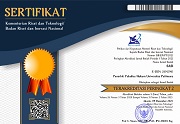Justice Connectivity in the Criminal Prosecution of Human Trafficking
 ), Mochammad Syafruddin Rezky Sanaky(2)
), Mochammad Syafruddin Rezky Sanaky(2)
(1) Bhayangkara Jakarta Raya University, Indonesia
(2) Auckland Law School, University of Auckland, New Zealand
 Corresponding Author
Corresponding Author
Abstract
Introduction: The involvement of members of the army of the Republic of Indonesia and The Police of the Republic of Indonesia became a special obstacle in the handling of human trafficking cases. The difficulties are due to the existence of special regulations governing the courts applicable to members of the Indonesian army who commit criminal acts.
Purposes of the Research: The case may be dealt with in conjunction with a criminal offense of trafficking in persons, given that the offense has fulfilled the element of involvement (also, deelneming) or jointly (mede dader) between a civilian and a person with military status in the criminal offense of trafficking.
Methods of the Research: The research used normative jurisprudence, focusing on primary legal material such as Act No. 21 of 2007 on Punishment of Trafficking in Persons, Law No. 31 of 1997 on Military Justice, and Law No. 2 of 2002 on the State Police of the Republic of Indonesia. The research was descriptive-analytical, interpreting the law according to its context and analyzing its results in a qualitative, descriptive manner. Secondary legal material included publications on human rights protection, particularly those relating to women and children. The fact approach was used to study human trafficking facts and provide critical analysis. Library documents, books, and journals were also analyzed. Data analysis involved document study techniques and qualitative analysis, with the results and author's analysis of relevant theories.
Results of the Research: The article addresses the Indonesian Army and Police's involvement in human trafficking offenses, emphasizing the intricacies and problems of prosecuting such instances. The author believes that the judicial system must promote justice and openness in such circumstances. The Indonesian legal system recognizes both military and civilian jurisdiction over crimes committed by military personnel, but implementation gaps cause uncertainty and delays in judicial processes. Handling crimes involving several institutions necessitates close teamwork, particularly among the Indonesian army and police. The mechanism to facilitate collaborative processing of human trafficking cases is connectedness justice, which decides which court has the authority to punish members of the Indonesian army for human trafficking.Keywords
DOI
10.47268/sasi.v30i1.1828
Published
2024-03-31
How To Cite
@article{SASI1828,
author = {Ika Saimima and Mochammad Sanaky},
title = {Justice Connectivity in the Criminal Prosecution of Human Trafficking},
journal = {SASI},
volume = {30},
number = {1},
year = {2024},
keywords = {Connection Court; Human Trafficking; Law Enforcement},
abstract = {Introduction: The involvement of members of the army of the Republic of Indonesia and The Police of the Republic of Indonesia became a special obstacle in the handling of human trafficking cases. The difficulties are due to the existence of special regulations governing the courts applicable to members of the Indonesian army who commit criminal acts.Purposes of the Research: The case may be dealt with in conjunction with a criminal offense of trafficking in persons, given that the offense has fulfilled the element of involvement (also, deelneming) or jointly (mede dader) between a civilian and a person with military status in the criminal offense of trafficking.Methods of the Research: The research used normative jurisprudence, focusing on primary legal material such as Act No. 21 of 2007 on Punishment of Trafficking in Persons, Law No. 31 of 1997 on Military Justice, and Law No. 2 of 2002 on the State Police of the Republic of Indonesia. The research was descriptive-analytical, interpreting the law according to its context and analyzing its results in a qualitative, descriptive manner. Secondary legal material included publications on human rights protection, particularly those relating to women and children. The fact approach was used to study human trafficking facts and provide critical analysis. Library documents, books, and journals were also analyzed. Data analysis involved document study techniques and qualitative analysis, with the results and author's analysis of relevant theories.Results of the Research: The article addresses the Indonesian Army and Police's involvement in human trafficking offenses, emphasizing the intricacies and problems of prosecuting such instances. The author believes that the judicial system must promote justice and openness in such circumstances. The Indonesian legal system recognizes both military and civilian jurisdiction over crimes committed by military personnel, but implementation gaps cause uncertainty and delays in judicial processes. Handling crimes involving several institutions necessitates close teamwork, particularly among the Indonesian army and police. The mechanism to facilitate collaborative processing of human trafficking cases is connectedness justice, which decides which court has the authority to punish members of the Indonesian army for human trafficking.},
issn = {2614-2961}, pages = {75--86} doi = {10.47268/sasi.v30i1.1828},
url = {https://fhukum.unpatti.ac.id/jurnal/sasi/article/view/1828}
}
Journal Article
Afandi, Rizqi, Fajar Sudewo, and Achmad Hamzani. “Implementation Of Judge’s Decisions On Decisions In Connection Cases Criminal Justice System,” 2022, 1–9. https://doi.org/10.4108/eai.28-5-2022.2320534.
Andi Hamzah. Penegakan Hukum Lingkungan. Jakarta: Arikha Media Cipta, 1995.
Arif, M. Yasin Al. “Penegakan Hukum Dalam Perspektif Hukum Progresif.” Undang: Jurnal Hukum 2, no. 1 (2019): 169–92. https://doi.org/10.22437/ujh.2.1.169-192.
Binsar Jon Vic S. “Challenges Facing Soes and Soe Subsidiaries Toward Business Tranformation Law Enforcement and Human Rights Protection (Post Constitutional Court Decision Number 01/PHPU-PRES/XVII/2019).” Journal Equity of Law and Governance 3, no. 1 (2023): 13–16. https://doi.org/10.55637/elg.3.1.6605.13-16.
Breen, Patricia D., and Brian D. Johnson. “Military Justice: Case Processing and Sentencing Decisions in America’s ‘Other’ Criminal Courts.” Justice Quarterly 35, no. 4 (2018): 639–69. https://doi.org/10.1080/07418825.2017.1335763.
Dwirivanda, Aditya Rizky. “Kebijakan Indonesia Terhadap Korban Kejahatan Perdagangan Orang Di Malaysia (2012-2017).” Journal of Interantional Relations 6, no. 3 (2020): 375–82.
Hasdianti, Fitri, and Johanna Debora Imelda. “The Role of Coping Strategy and Legal Protection on Migrant Workers: A Literature Review.” Jurnal IUS Kajian Hukum Dan Keadilan 10, no. 3 (2022): 462–74. https://doi.org/10.29303/ius.v10i3.908.
Kiss, Ligia, and Cathy Zimmerman. “Human Trafficking and Labor Exploitation: Toward Identifying, Implementing, and Evaluating Effective Responses.” PLoS Medicine 16, no. 1 (2019): 1–4. https://doi.org/10.1371/journal.pmed.1002740.
Rinanda, R, and H Helvis. “Analisis Hukum Peran Pembantu Dalam Tindak Pidana Perdagangan Orang Terhadap Terdakwa Yang Merupakan Anggota Polri.” JCA of Law 1, no. 2 (2020). https://jca.esaunggul.ac.id/index.php/law/article/view/27.
Sumirat, Iin Ratna. “Penegakan Hukum Dan Keadilan Dalam Bingkai Moralitas Hukum.” Al Qisthas Jurnal Hukum Dan Politik 11, no. 2 (2021): 86–100. https://doi.org/10.37035/alqisthas.v11i2.3827.
Book
Hans Kelsen. Introduction To The Problems of Legal Theory of Law. Oxford: Clarendon Press, 1992.
Soekanto, Soerjono. Faktor-Faktor Yang Mempengaruhi Penegakan Hukum. Jakarta: PT.Raja Grafindo Persada, 2012.
Thesis, Online/World Wide Web and Others
Dedi Hermawan. “Kerangkeng Manusia Di Rumah Bupati Langkat: Komnas HAM Temukan ‘Besi Panas’ Palu’, Alat Dalam 26 Bentuk Kekerasan Dan Keterlibatan Anggota TNI-Polri.” bbcindonesia, 2022. https://www.bbc.com/indonesia/indonesia-60122292.
Divisi Humas Polri. “Selama 51 Hari, Polri Selamatkan 2.186 Korban TPPO,” 2023. https://humas.polri.go.id/2023/07/26/selama-51-hari-polri-selamatkan-2-186-korban-tppo/.
Fraksi Partai Keadilan Sejahtera. “Kasus Perdagangan Orang Masih Terus Berlanjut, PKS: Pemerintah Harus Segera Bertindak!,” 2023. https://fraksi.pks.id/2023/06/12/kasus-perdagangan-orang-masih-terus-berlanjut-pks-pemerintah-harus-segera-bertindak/.
Giri. “Oknum TNI, Polri, Bahkan Di Internal BP2MI Terlibat Dalam Kasus Perdagangan Orang Yang Masih Marak Artikel Ini Telah Tayang Di TribunJabar.Id Dengan Judul Oknum TNI, Polri, Bahkan Di Internal BP2MI Terlibat Dalam Kasus Perdagangan Orang Yang Masih Marak.” TribunJabBar, 2023. https://jabar.tribunnews.com/2023/06/13/oknum-tni-polri-bahkan-di-internal-bp2mi-terlibat-dalam-kasus-perdagangan-orang-yang-masih-marak.
Hidayati, Maslihati Nur. “Upaya Pemberantasan Dan Pencegahan Perdagangan Orang Melalui Hukum Internasional Dan Hukum Positif Indonesia.” Jurnal Al-Azhar Indonesia Seri Pranata Sosial 1, no. 3 (2012): 163–74. Persoalan perdagangan orang saat ini telah menjadi suatu keprihatinan bagi dunia internasional. Hal ini mengingat sejumlah pelanggaran Hak Asasi Manusia (dan untuk selanjutnya disingkat menjadi HAM) dianggap sebagai penyebab dan sekaligus akibat dari perd.
Kedutaan Besar dan Konsulat Amerika Serikat. “Laporan Tahunan Perdagangan Orang 2022,” 2022. https://id.usembassy.gov/id/our-relationship-id/official-reports-id/laporan-tahunan-perdagangan-orang-2022/.
Luxiana, Kadek Melda. “Komnas HAM Ungkap Keterlibatan Oknum TNI-Polri Di Kerangkeng Bupati Langkat.” detiknews, 2022. https://news.detik.com/berita/d-5965690/komnas-ham-ungkap-keterlibatan-oknum-tni-polri-di-kerangkeng-bupati-langkat.
Nirmala Maulana Achmad. “Kepala BP2MI: Ada Oknum Polri Dan TNI Terlibat Dalam Kasus TPPO, Bahkan Di BP2MI,” 2023. https://nasional.kompas.com/read/2023/07/04/18104081/kepala-bp2mi-ada-oknum-polri-dan-tni-terlibat-dalam-kasus-tppo-bahkan-di.
S.R. Sianturi. Hukum Pidana Militer. Jakarta, 2011.
Santi Dewi. “Jenderal Andika Akui 2 Anggota TNI Terlibat Kirim PMI Ilegal.” IDN Times, 2021. https://www.idntimes.com/news/indonesia/santi-dewi/jenderal-andika-akui-2-anggota-tni-terlibat-kirim-pmi-ilegal.
Sistem Informasi Online Perlindungan Perempuan dan Anak. “Data Kekerasan Terhadap Perempuan Dan Anak,” 2022. https://kekerasan.kemenpppa.go.id/register/login.| Dublin Core | PKP Metadata Items | Metadata for this Document | |
| 1. | Title | Title of document | Justice Connectivity in the Criminal Prosecution of Human Trafficking |
| 2. | Creator | Author's name, affiliation, country | Ika Dewi Sartika Saimima; Bhayangkara Jakarta Raya University; Indonesia |
| 2. | Creator | Author's name, affiliation, country | Mochammad Syafruddin Rezky Sanaky; Auckland Law School, University of Auckland; New Zealand |
| 3. | Subject | Discipline(s) | |
| 3. | Subject | Keyword(s) | Connection Court; Human Trafficking; Law Enforcement |
| 4. | Description | Abstract | Introduction: The involvement of members of the army of the Republic of Indonesia and The Police of the Republic of Indonesia became a special obstacle in the handling of human trafficking cases. The difficulties are due to the existence of special regulations governing the courts applicable to members of the Indonesian army who commit criminal acts.Purposes of the Research: The case may be dealt with in conjunction with a criminal offense of trafficking in persons, given that the offense has fulfilled the element of involvement (also, deelneming) or jointly (mede dader) between a civilian and a person with military status in the criminal offense of trafficking.Methods of the Research: The research used normative jurisprudence, focusing on primary legal material such as Act No. 21 of 2007 on Punishment of Trafficking in Persons, Law No. 31 of 1997 on Military Justice, and Law No. 2 of 2002 on the State Police of the Republic of Indonesia. The research was descriptive-analytical, interpreting the law according to its context and analyzing its results in a qualitative, descriptive manner. Secondary legal material included publications on human rights protection, particularly those relating to women and children. The fact approach was used to study human trafficking facts and provide critical analysis. Library documents, books, and journals were also analyzed. Data analysis involved document study techniques and qualitative analysis, with the results and author's analysis of relevant theories.Results of the Research: The article addresses the Indonesian Army and Police's involvement in human trafficking offenses, emphasizing the intricacies and problems of prosecuting such instances. The author believes that the judicial system must promote justice and openness in such circumstances. The Indonesian legal system recognizes both military and civilian jurisdiction over crimes committed by military personnel, but implementation gaps cause uncertainty and delays in judicial processes. Handling crimes involving several institutions necessitates close teamwork, particularly among the Indonesian army and police. The mechanism to facilitate collaborative processing of human trafficking cases is connectedness justice, which decides which court has the authority to punish members of the Indonesian army for human trafficking. |
| 5. | Publisher | Organizing agency, location | Faculty of Law, Universitas Pattimura |
| 6. | Contributor | Sponsor(s) | |
| 7. | Date | (YYYY-MM-DD) | 2024-03-31 |
| 8. | Type | Status & genre | Peer-reviewed Article |
| 8. | Type | Type | |
| 9. | Format | File format | |
| 10. | Identifier | Uniform Resource Identifier | https://fhukum.unpatti.ac.id/jurnal/sasi/article/view/1828 |
| 10. | Identifier | Digital Object Identifier | 10.47268/sasi.v30i1.1828 |
| 11. | Source | Title; vol., no. (year) | SASI; Volume 30 Issue 1, March 2024 |
| 12. | Language | English=en | en |
| 13. | Relation | Supp. Files |
Turnitin Justice COnnectivity (2MB) |
| 14. | Coverage | Geo-spatial location, chronological period, research sample (gender, age, etc.) | |
| 15. | Rights | Copyright and permissions | Copyright: Authors who publish their manuscripts in this Journal agree to the following conditions: 1. The copyright in each article belongs to the author, as well as the right to patent. 2. Authors can enter into separate, additional contractual arrangements for the non-exclusive distribution of the journal's published version of the work (e.g., post it to an institutional repository or publish it in a book), with an acknowledgment of its initial publication in this journal. 3. Authors are permitted and encouraged to post their work online (e.g., in institutional repositories or on their website) before and during the submission process, as it can lead to productive exchanges, as well as earlier and greater citation of published work. 4. Authors have the right to self-archiving of the article (Author Self-Archiving Policy)
License: The SASI Journal is disseminated based on the Creative Commons Attribution-NonCommercial 4.0 International license terms. This license allows anyone to copy and redistribute this material in any form or format, compose, modify, and make derivatives of this material for any purpose. You cannot use this material for commercial purposes. You must specify an appropriate name, include a link to the license, and certify that any changes have been made. You can do this in a way that is appropriate but does not imply that the licensor supports you or your use.
|
Copyright (c) 2024 Ika Dewi Sartika Saimima, Mochammad Syafruddin Rezky Sanaky

This work is licensed under a Creative Commons Attribution-NonCommercial 4.0 International License.

 : 2024 times
: 2024 times Download : 1398 times
Download : 1398 times
















